Unlocking Culinary Excellence: Your Guide to Choosing the Perfect Stainless Steel Chef Knife
A chef’s knife is the backbone of any serious kitchen. It’s the workhorse that handles the majority of your chopping, slicing, dicing, and mincing. But with a seemingly endless array of options available, choosing the right stainless steel chef’s knife can feel overwhelming. This comprehensive guide breaks down the key factors to consider, helping you find the perfect blade to elevate your culinary game.
Why Stainless Steel Reigns Supreme
While carbon steel knives offer exceptional sharpness, stainless steel knives have become the popular choice for home cooks and professionals alike. Their resistance to rust and corrosion makes them far more durable and easier to maintain. High-quality stainless steel also boasts excellent edge retention, meaning your knife will stay sharp for longer, requiring less frequent sharpening. The non-reactive nature of stainless steel also ensures your food won’t pick up any metallic tastes.
Blade Length: Finding Your Perfect Fit
The length of your chef’s knife significantly impacts its versatility. A longer blade (8-10 inches) provides greater reach and is ideal for larger tasks like chopping vegetables or butchering meat. Shorter blades (6-8 inches) are more maneuverable and perfect for smaller cutting boards or intricate work. Consider your typical cooking style and the size of your ingredients when making your decision. For most home cooks, an 8-inch blade strikes a good balance between versatility and maneuverability.
Steel Grade: The Heart of the Blade

Not all stainless steel is created equal. The grade of steel directly impacts the knife’s hardness, durability, and edge retention. Look for knives made from high-carbon stainless steel, often indicated by numbers and letters in the description (e.g., 440C, 154CM, AUS-10). Higher numbers generally translate to better performance. Researching specific steel grades can provide insight into their properties and performance levels.
Handle: Comfort and Control

The handle is crucial for comfort and control during use. Different materials offer distinct benefits: wood handles offer a warm, classic feel, but require more maintenance. Synthetic materials like polypropylene or pakkawood are durable, easy to clean, and resistant to moisture. The handle’s shape and size should fit comfortably in your hand, allowing for a secure grip without strain. Consider ergonomic designs that reduce wrist fatigue during extended use.
The Importance of Blade Geometry

The way the blade is ground (its geometry) significantly affects its performance. A full bolster (the metal that extends from the blade to the handle) provides balance and protection for your fingers. A half bolster or no bolster offers increased maneuverability but requires extra caution. The blade’s edge itself is also crucial. A finely honed edge ensures clean cuts while a thicker edge is more durable. The bevel angle (the angle of the sharpened edge) also impacts cutting efficiency and longevity. A thinner bevel (around 15 degrees) is sharper, while a thicker bevel is more durable.
Sharpening Considerations
Regardless of the knife’s quality, regular sharpening is essential to maintain its performance. Consider investing in a quality sharpening steel or honing rod for daily maintenance, and a sharpening stone for periodic re-sharpening. Proper sharpening techniques can prolong the life of your blade significantly.
Budget-Friendly vs. High-End: Balancing Quality and Cost
Chef’s knives range in price from budget-friendly options to high-end professional models. While a high-end knife will typically boast superior materials and craftsmanship, a well-made mid-range knife can provide excellent performance for most home cooks. Consider your budget and usage frequency when selecting a knife. A more expensive knife represents a long-term investment that pays off in years of reliable service. Look for reputable brands with strong warranties.
Comparing Popular Brands
Many reputable brands produce high-quality stainless steel chef’s knives. Research popular brands like Shun, Wüsthof, Global, Victorinox, and Henckels to understand their features, price points, and customer reviews. Comparing different models and reading online reviews can help you make an informed choice based on your needs and preferences.
Maintenance and Care: Keeping Your Knife Sharp
Proper care extends the lifespan of your chef’s knife. Always hand wash your knife with warm soapy water and dry it thoroughly immediately. Avoid placing your knife in the dishwasher, as the high temperatures and harsh detergents can damage the blade and handle. Store your knife safely in a knife block, magnetic strip, or protective sheath to prevent damage and accidents.
Final Thoughts: Choosing Your Culinary Companion

Selecting the right stainless steel chef’s knife is a crucial step in enhancing your culinary experience. By carefully considering blade length, steel grade, handle comfort, blade geometry, and your overall budget, you can find a knife that meets your needs and elevates your cooking skills for years to come. Don’t hesitate to test out different knives in a store before committing to a purchase to ensure a comfortable and secure grip.